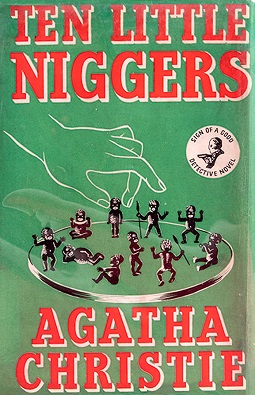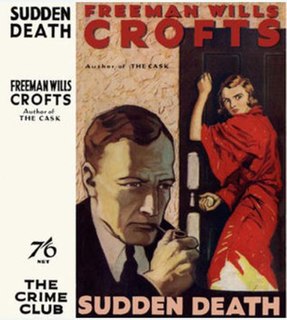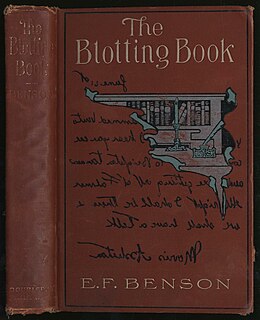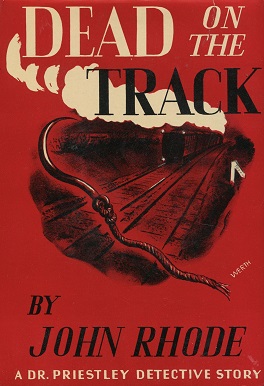
Detective fiction is a subgenre of crime fiction and mystery fiction in which an investigator or a detective—either professional, amateur or retired—investigates a crime, often murder. The detective genre began around the same time as speculative fiction and other genre fiction in the mid-nineteenth century and has remained extremely popular, particularly in novels. Some of the most famous heroes of detective fiction include C. Auguste Dupin, Sherlock Holmes, and Hercule Poirot. Juvenile stories featuring The Hardy Boys, Nancy Drew, and The Boxcar Children have also remained in print for several decades.

Crime fiction, detective story, murder mystery, mystery novel, and police novel are terms used to describe narratives that centre on criminal acts and especially on the investigation, either by an amateur or a professional detective, of a crime, often a murder. It is usually distinguished from mainstream fiction and other genres such as historical fiction or science fiction, but the boundaries are indistinct. Crime fiction has multiple subgenres, including detective fiction, courtroom drama, hard-boiled fiction, and legal thrillers. Most crime drama focuses on crime investigation and does not feature the courtroom. Suspense and mystery are key elements that are nearly ubiquitous to the genre.
Ellery Queen is a pseudonym created in 1929 by American crime fiction writers Frederic Dannay and Manfred Bennington Lee and the name of their main fictional character, a mystery writer in New York City who helps his police inspector father solve baffling murders. Dannay and Lee wrote most of the more than thirty novels and several short story collections in which Ellery Queen appeared as a character, and their books were among the most popular of American mysteries published between 1929 and 1971. In addition to the fiction featuring their eponymous brilliant amateur detective, the two men acted as editors: as Ellery Queen they edited more than thirty anthologies of crime fiction and true crime, and Dannay founded and for many decades edited Ellery Queen's Mystery Magazine, which has been published continuously from 1941 to the present. From 1961, Dannay and Lee also commissioned other authors to write crime thrillers using the Ellery Queen nom de plume, but not featuring Ellery Queen as a character; several juvenile novels were credited to Ellery Queen, Jr. Finally, the prolific duo wrote four mysteries under the pseudonym Barnaby Ross.
Michael Francis Gilbert was an English solicitor and author of crime fiction.

Murder in Mesopotamia is a work of detective fiction by British writer Agatha Christie, first published in the UK by the Collins Crime Club on 6 July 1936 and in the US by Dodd, Mead and Company later in the same year. The UK edition retailed at seven shillings and sixpence (7/6) and the US edition at $2.00. The cover was designed by Robin McCartney.
The Golden Age of Detective Fiction was an era of classic murder mystery novels of similar patterns and styles, predominantly in the 1920s and 1930s.
Dorothy B. Hughes was an American crime writer, literary critic, and historian. Hughes wrote fourteen crime and detective novels, primarily in the hardboiled and noir styles, and is best known for the novels In a Lonely Place (1947) and Ride the Pink Horse (1946).

And Then There Were None is a mystery novel by the English writer Agatha Christie, described by her as the most difficult of her books to write. It was first published in the United Kingdom by the Collins Crime Club on 6 November 1939, as Ten Little Niggers, after the children's counting rhyme and minstrel song, which serves as a major plot element. The US edition was released in January 1940 with the title And Then There Were None, taken from the last five words of the song. Successive American reprints and adaptations use that title, though Pocket Books paperbacks used the title Ten Little Indians between 1964 and 1986. UK editions continued to use the original title until 1985.
Robert Lloyd Fish was an American writer of crime fiction.

Sara Sheridan is a Scottish activist and writer who works in a variety of genres, though predominantly in historical fiction. She is the creator of the Mirabelle Bevan mysteries.

Brighton Belle is a novel written by Scottish writer Sara Sheridan. The book was first published by Polygon Books in 2012 and is the first in the series of the Mirabelle Bevan mysteries.

Sudden Death is a 1932 detective novel by the Irish writer Freeman Wills Crofts. It is the eighth in his series of novels featuring Inspector French, a prominent figure of the Golden Age of Detective Fiction.
Brighton Belle (1931-1972) a named train from the UK

Tom Brown's Body is a 1949 mystery detective novel by the British writer Gladys Mitchell. It is the twenty second in her long-running series featuring the psychoanalyst and amateur detective Mrs Bradley. The title refers to both the novel Tom Brown's School Days and the song John Brown's Body. Mitchell had previously used a school setting for her earlier work Death at the Opera.

The Blotting Book is a 1908 mystery crime novel by the British writer E.F. Benson, later better known as the author of the Mapp and Lucia series. It was one of only two ventures he made into the genre during his prolific career along with The Luck of the Vails (1901). It takes place in Brighton and the nearby South Downs.

The Whip Hand is a 1965 spy novel by the British writer Victor Canning. It is the first in a series of four novels about Rex Carver, a private detective drawn back into his old profession of espionage. The novel also features the secret service agent Manston who had previously appeared in The Limbo Line, Canning's previous novel.

Vegetable Duck is a 1944 detective novel by John Rhode, the pen name of the British writer Cecil Street. It is the fortieth in his long-running series of novels featuring Lancelot Priestley, a Golden Age armchair detective. The title refers to a dish including a Marrow stuffed with minced beef, which features in the plot. It has been described as "one of the oddest titles for a detective novel in the genre". Although written during wartime, the setting was post-war. It was published in America by Dodd Mead under the alternative title Too Many Suspects.

Dead on the Track is a 1943 detective novel by John Rhode, the pen name of the British writer Cecil Street. It is the thirty seventh in his long-running series of novels featuring Lancelot Priestley, a Golden Age armchair detective. Like a number of mystery novels of the era, it has a railway setting. In theme and plot it is very similar to the author's earlier 1931 work Tragedy on the Line. It is the first entry in the series since Hendon's First Case (1935) in which Priestley's old associate Hanslet is the lead investigator. The other recurring police officer in the series Inspector Jimmy Waghorn is now working with military intelligence.

Death on the Boat Train is a 1940 detective novel by John Rhode, the pen name of the British writer Cecil Street. It is the thirty second in his long-running series of novels featuring Lancelot Priestley, a Golden Age armchair detective. As in most of the later novels much of the detective footwork is done by Inspector Waghorn of Scotland Yard. The construction of the murder setting bears similarities to Death in the Tunnel, written by Street under his other pen name Miles Burton. With is focus on seemingly unbreakable alibis and railway and ship timetables, it is also similar in style to the Inspector French novels of Freeman Wills Crofts.

Death on the Riviera is a 1952 detective novel by the British writer John Bude. It was part of a series featuring Superintendent Meredith of Scotland Yard. While Bude set many of his earlier novels in regional England, after the Second World War they made increasing use of more exotic, Continental settings. In 2016 it was reissued by the British Library Publishing as part of a group of republished crime novels from the Golden Age of Detective Fiction.














